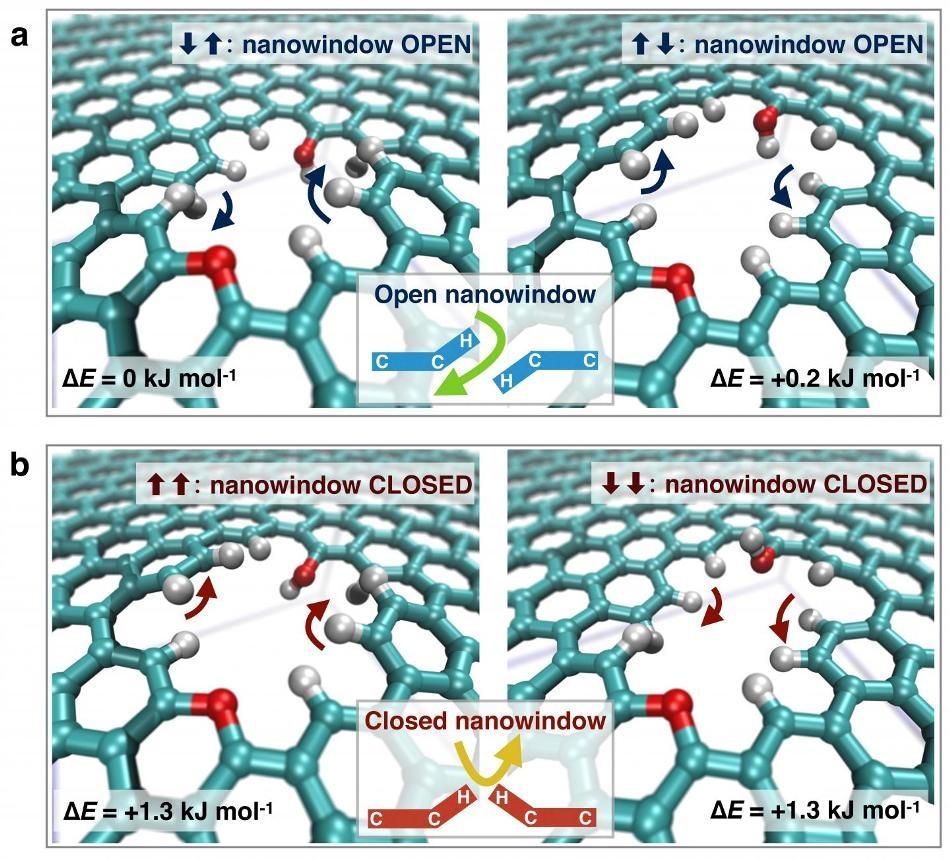Jun 5 2018
Nanoscale holes in graphene (termed as "nanowindows") are different from the windows of a house, and can selectively choose the type of air molecules that can pass through.
 Graphene has phonon motion and local oscillations, which gives rise to concerted vibrations in the nanowindow rim. (Credit: Copyright 2018, Nature Communications, Licensed under CC BY 4.0)
Graphene has phonon motion and local oscillations, which gives rise to concerted vibrations in the nanowindow rim. (Credit: Copyright 2018, Nature Communications, Licensed under CC BY 4.0)
A research team from Shinshu University and PSL University, France, hypothetically proved the concerted movement of the nanowindow-rim to selectively enable the passage of molecules in a fast and energy-efficiently manner. This study presents new opportunities to develop a sophisticated molecular separation membrane technology.
The unique mechanism of separation by nanowindows is that the effective nanowidow size is changed by the atomic vibration of the nanowindow-rim.
By deviating the rim of one side and then deviating the other to the opposite direction, the effective nanowindow size turns out to be larger than when the rim does not move. This kind of effect is quite predominant for molecules of argon, oxygen, and nitrogen, promoting an efficient separation of oxygen from air.
In this study, separation of the key components of air such as nitrogen, oxygen, and argon was considered. These components have high industrial requirements; there has been a great demand for novel air separation technology. The molecular sizes of nitrogen, oxygen, and argon are 0.305, 0.299, and 0.363 nanometers (nm), respectively. The permeation of these molecules was subsequently compared with six differently-sized nanowindows — i.e., 0.257 nm, 0.273 nm, 0.297 nm, 0.330 nm, 0.370 nm, and 0.378 nm.
Oxidation treatment was used to prepare nanowindows. Therefore, the rims of these nanowindows are passivated with oxygen and hydrogen atoms, which play an important role in selective permeation.
Remarkably, it was observed that even when the size of the rigid nanowindow is smaller than the target molecular size, the molecules were able to permeate through nanowindows. For instance, O2 permeates faster through 0.29 nm nanowindows when compared to 0.33 nm nanowindows. This variation in permeation rate is related to the interaction of the molecule with graphene and the nanowidow rim. The special mechanism is further elucidated by using vibrational motion and interaction energy of the hydrogen and oxygen at the nanowindow rim.
In the nanoscale, the local electric field emerging from the nanowindow rim having oxygen and hydrogen atoms is sufficiently large to establish the orientation of nitrogen and oxygen molecules, providing a highly selective permeation via nanowindows that are smaller than oxygen molecules. This selectivity sensitively mainly relies on the property and structure of a gas molecule as well as the rim-chemistry and geometry (shape and size) of nanowindows.
The effective size of the window is altered by about 0.01 nm due to the concerted orientational motions of the oxygen and hydrogen atoms at the nanowindow rim, brought about by thermal vibrations. The nanowindow can be opened for desired molecules (here, oxygen gas) by the concerted vibration at the nanowindow rim.
In this research, mixed gas permeation was evaluated for measuring selectivities. At ambient temperature, separation efficiencies surpassed 1500 and 50 for O2/Ar and O2/N2, respectively. Although prevalent membranes have achieved permeation rate selectivities of 6 for O2/N2, they lack high permeation rate. This demonstrates promising probability of developing dynamic nanowindows in graphene.
At present, air separation in industry is performed through distillation, which requires an enormous amount of energy. Gases used in this research are largely used in different industries, such as steel, food, medical, and so on. Developing graphene embedded with dynamic nanowindows will save a considerable amount of energy and enable highly efficient and safer process. This research indicates the future course of the air separation process.